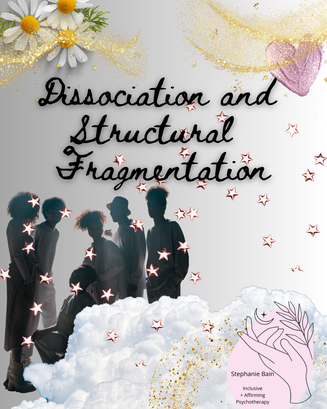|
Do you dissociate? Yea, probably... As a trauma therapist in Oakland, CA, I am commonly asked about dissociation. Dissociation seems to be a popular topic... The Evolution of The Concept of DissociationThe concept of dissociation has evolved over time, leading to different understandings and definitions of the term. Initially, the term "dissociation" was primarily associated with the idea of "fragmentation of identity." However, in more modern psychological and psychiatric contexts, the understanding of dissociation has broadened to encompass a wider range dissociative experiences, including the good old fashioned "zoning out" that we all do.
Modern definitions of dissociation include:
Fragmentation of Identity:The original conceptualization of dissociation refers to the experience of feeling divided or disconnected within oneself. It may involve experiencing conflicting thoughts, emotions, or self-perceptions that create a sense of internal dissonance. The individual may feel like they have different parts or aspects of themselves that do not fully integrate or communicate effectively with each other. How Trauma Impacts Fragmentation: Developmental trauma (or complex trauma) can create fragmentation within an individual's personality due to the overwhelming nature of the traumatic experiences, especially during critical stages of development. When exposed to significant and ongoing trauma, particularly in childhood, a person's coping mechanisms may not be fully developed, leading to dissociation as a protective response.
The Function of Fragmentation: Developmental trauma, such as abuse, neglect, or repeated exposure to distressing events, can be too much for a young child's developing mind to process and integrate. To protect themselves from emotional and psychological harm, the child's mind may employ defense mechanisms, such as dissociation, to compartmentalize and distance from the traumatic experiences. Dissociation involves a range of experiences, from feeling emotionally detached to losing memories of traumatic events. During moments of significant trauma, dissociation can be a way for the mind to "freeze" certain parts of the personality or emotional experiences, effectively separating them from conscious awareness.
When dissociation occurs repeatedly in response to trauma, distinct parts of the personality may emerge or "split off" to contain the overwhelming emotions and experiences associated with specific traumatic events. These dissociative parts may remain separate from the individual's core sense of self and awareness. he presence of dissociative parts can lead to a fragmented sense of self. Instead of experiencing a cohesive and integrated identity, the person may feel like they have multiple aspects, each holding different emotions, memories, and reactions related to the traumatic experiences. Common experiences of fragmentation include:
Healing Dissociation and FragmentationBy recognizing and engaging with the dissociative parts in a supportive and non-judgmental manner, individuals can gradually integrate these parts into a more unified and resilient sense of self, leading to healing and improved emotional well-being. A parts work lens can facilitate healing by helping individuals with internal fragmentation and dissociation to develop self-awareness, compassionately engage with their different parts or aspects, and foster integration, allowing for a more cohesive and harmonious sense of self and improved emotional regulation. Additional trauma processing (like EMDR, somatic work, insight based talk therapy) may be necessary along with potential skill building (DBT, relational psychotherapy, group work). Do I Dissociate?
0 Comments
Leave a Reply. |
AuthorStephanie Bain, LMFT Archives
April 2024
Categories
All
***Resources are not a substitute for therapy and are not intended for making diagnoses or providing treatment. Not all practices and tools are suitable for every person. Please discuss exercises, practices, and tools with your individual therapist or health care provider.
|


 RSS Feed
RSS Feed